Ready to level up your swimming? Here are eight stretches for swimmers for more range of motion, increased power, and faster swimming in the pool.
From an early age, from the summer league swimming days until we hang up our racing suit for the last time, we are reminded of the importance of stretching.
Stretching is like eating your vegetables; we know it’s healthy and good for us, but we resist it, typically because we are already spending a ton of time at the pool, and the last thing we want to do is do more.
But guess what buckeroo: Stretching before swimming will make your swims more effective, help you swim with better technique, and yup, reduce the likelihood of injury.
(Especially when you are doing the right type of stretches at the right time…)
Fortunately, for swimmers who aren’t super keen on hitting the stretching mat before swimming, there are some time-effective ways to increase mobility and performance without tacking on an extra half hour to an already busy training day.
In this article, we will look at some essential dynamic and static stretches for swimmers that will help prime you for better swim workouts and also help you reset after the big main set is over.
Let’s dive in.
Essential Stretches for Swimmers
This guide will cover eight specific stretches to help limber you up for peak performance in the water.
They include:
- Arm swings
- Leg swings
- Ankle circles
- Quadruped T-spine rotation
- Low back crossover
- Kneeling hip flex stretch
- Doorway pec stretch
- Lat stretch
Next, we will look at each stretch, its benefits for swimmers, and tips for doing them like a chlorinated champion.
1. Arm swings
Let’s start with arm swings, a form of dynamic stretching that most swimmers are more than familiar with.
Arm swings, in all of their variations, improve the range of motion, increase blood flow, and activate the targeted muscle groups in the upper body.
A study published in the Journal of Strength and Conditioning Research (Hough et al., 2009) discovered that dynamic stretches were notably more effective than static stretching at boosting muscle activation and improving vertical jump performance.
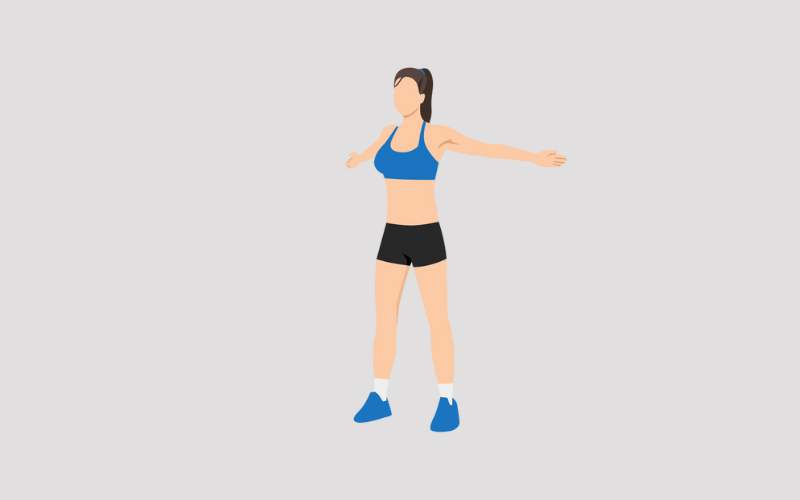
Another study published in the Journal of Sports Science and Medicine (Iwata et al., 2019) found that dynamic stretching significantly reduced passive muscle stiffness.
Arm swings are awesome for shaking loose stiffness, promoting blood flow to target muscles, and increasing range of motion while cranking up athletic performance.
Giddyup!
The arm swings swimmers should consider including in their stretching routine include the following standbys:
Cross-body arm swings
The classic, the O.G., the one you will see just about every swimmer doing behind the blocks before a big race or a big practice.
Starting with your arms extended out to the side, swing them together in front of you, arm criss-crossing, before swinging them backward.
Cross-body arm swings are dynamic stretches that open up the chest, shoulders, and upper back.
The most famous example of this stretch is Michael Phelps’s two-arm swing routine on the blocks (he is bent over when doing this; standing up and doing it is fine, too!).
Overhead arm swings
Standing straight, swing your arms side-to-side so that one arm crosses in front of you and the other reaches around the back of your head, touching the opposing shoulder.
This stretch is excellent for swimmers as it loosens and opens up the lats and triceps, which tend to sit dormant over the day when not in the water.
Trunk swings
Extending your arms, swing them around to each side of your body, rotating the shoulders while keeping the hips stationary.
See also: 10 Dryland Workouts for Swimming
These arm swings are more of an upper body stretch, as they help open up your spine, trunk, and hips and mimic the side-to-side rotation freestylers perform in the water.
Consider adding 20-25 repetitions of each before your next swim, and you’ll find it easier to reach further in the water, rotate more efficiently, and nail that early vertical forearm.
2. Leg swings
Leg swings are another form of dynamic stretching that are perfect for swimmers to use either before swim workouts, or after long periods of sitting, or in the hours after a brutal swim workout, when you want to shake some of the rust and soreness out.
The research with leg swings and dynamic stretching is solid. One study titled “Acute Effects of Dynamic Stretching Followed by Vibration Foam Rolling on Sports Performance of Badminton Athletes,” showed that a dynamic lower body stretching routine significantly increased knee range of motion, jumping performance, and overall agility.
My two favorite leg stretches swimmers should drop into their day-to-day training and recovery routine are leg swings from front-to-back and side-to-side.
Front-to-back leg swings
Grab something to steady yourself with, slightly bend the stationary leg, and swing the other leg gently forward and backward.
You’ll find that even after just 7-8 swings, the leg will swing higher in both directions.
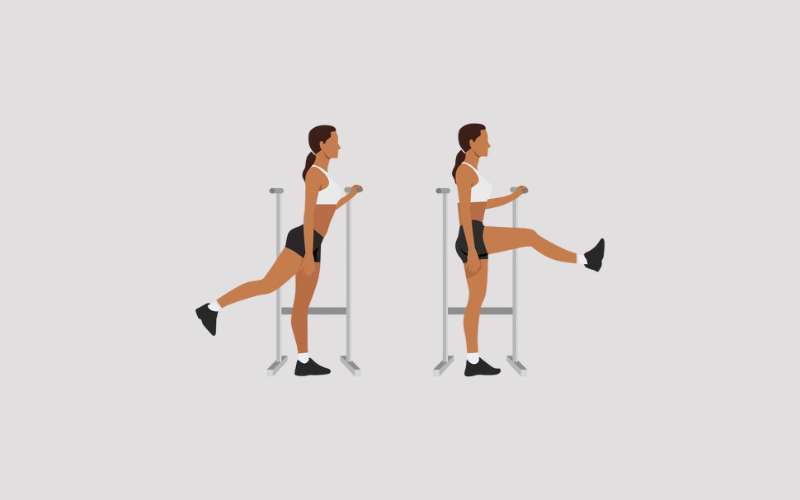
Front-to-back leg swings are particularly effective at loosening up the hip flexors, quad muscles, hamstrings, and groin.
Side-to-side leg swings
Side-to-side leg swings, also known as lateral leg swings, are excellent for opening up the hips, and inner and outer thighs.
Grab something sturdy to hold onto, position the swinging leg slightly in front of you, and swing out laterally. You’ll feel it, particularly in the outer thighs and hips, as the leg apexes as it swings outwards.
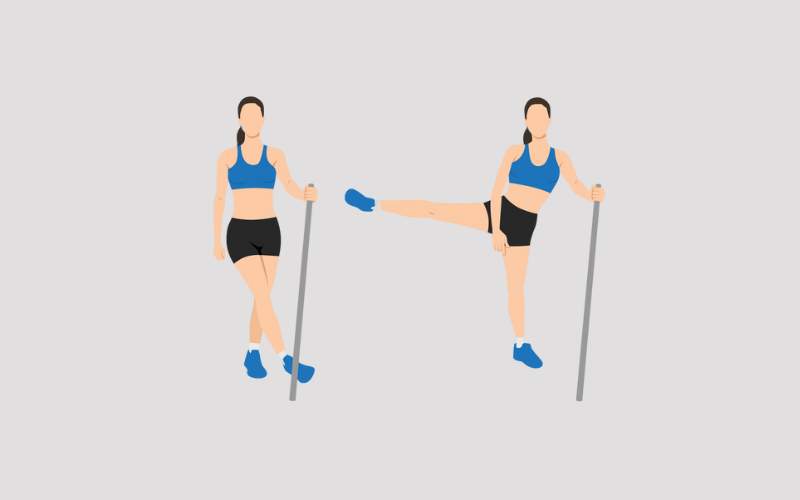
Swing the leg back in front of you and repeat as necessary.
Leg swings, like the arm swings earlier, promote blood flow to the hips and legs, priming them for a successful swim while increasing the overall range of motion.
3. Ankle circles
Ankle flexibility is crucial for swimmers to be able to kick efficiently. The more flexible your ankle, the more water you can kick.
A study published in the Journal of Strength Conditioning Research took members of the women’s University of Connecticut swimming team and assessed ankle flexibility, foot size, and vertical jump power.
The thing that separated the good kickers from the great kickers?
Ankle flexibility.
The swimmers with better ankle plantar flexion both kicked faster and swam faster.
There are a few ways swimmers can increase ankle flexibility, but my favorite (that doesn’t require sitting on your ankles for “ankle rockers”) is the simple ankle circle.
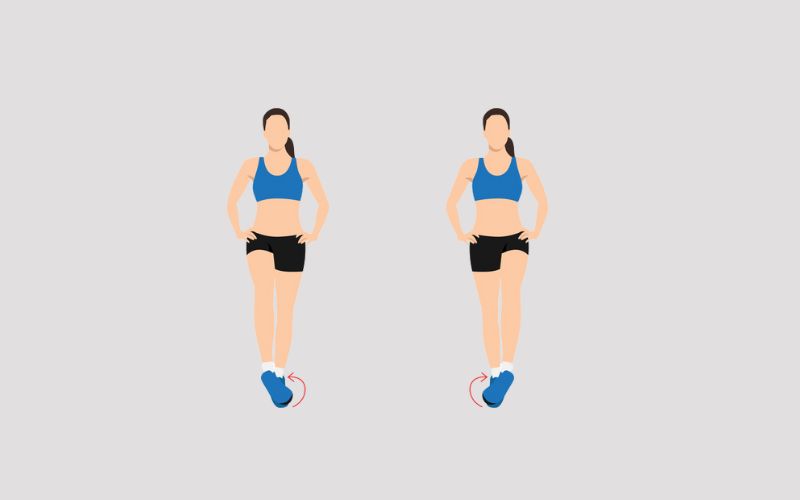
Sitting or standing, extend your foot and point the toes. Using your toes as a pointer, draw the biggest circle you can without moving your ankle. Do 10-15 reps in each direction and switch foot.
I love the accessibility of this dynamic stretch for swimmers, which you can do anywhere, anytime.
Fun fact—I’m doing them right now at my desk as I write this.
4. Quadruped T-spine Rotation
Swimmers are blessed with massive shoulders. But with all the muscle that comes with big shoulders and that big V-shaped back comes tension and stiffness in the upper back, neck, and shoulders.
Especially when you combine all that upper body work in the water with slouching and sitting on the dry side of the pool.
My favorite stretch for pushing back stiffness and tension in the upper body?
The quadruped T-spine rotation.
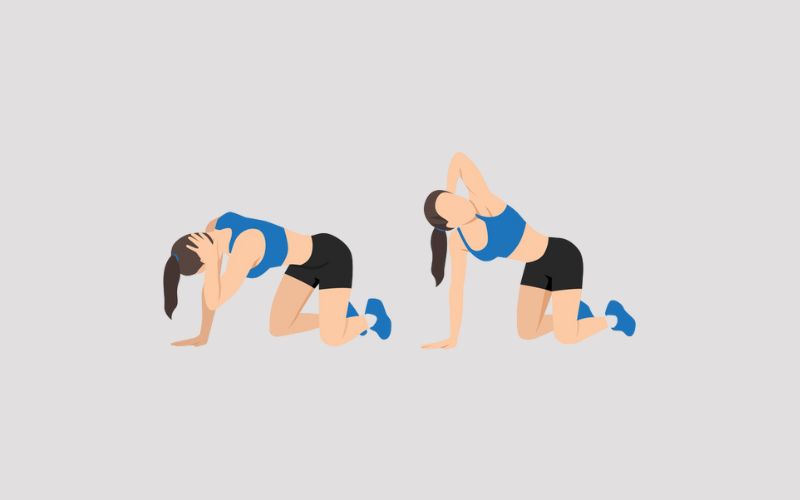
Here’s how to do this stretch like a boss:
- Slink down to the floor and get on all fours (this is what quadruped means) with your hands directly below the shoulders.
- Place your right hand on the back of your head.
- Using your elbow to guide the movement, rotate so that it (tries to) points toward the ceiling.
- Rotate back so that your elbow points at your left hand (this will give you a pleasant and gentle stretch in your scaps—relaxation 9000!).
- Repeat 5-10 and switch sides.
This stretch for swimmers should also rank high in the list of stretches for sprint freestylers, who swim with largely flat hips and need extra rotational range in the shoulders.
5. Trunk Rotation with Leg Crossover
Swimmers, particularly freestylers and backstrokers, need full access to the rotational power from their core and hips.
See also: 8 Best Core Exercises for Swimmers
Stiff hips and lower back reduce the ability to rotate correctly, stretch out to maximize distance per stroke, and unleash a furious underwater dolphin kick off the walls.
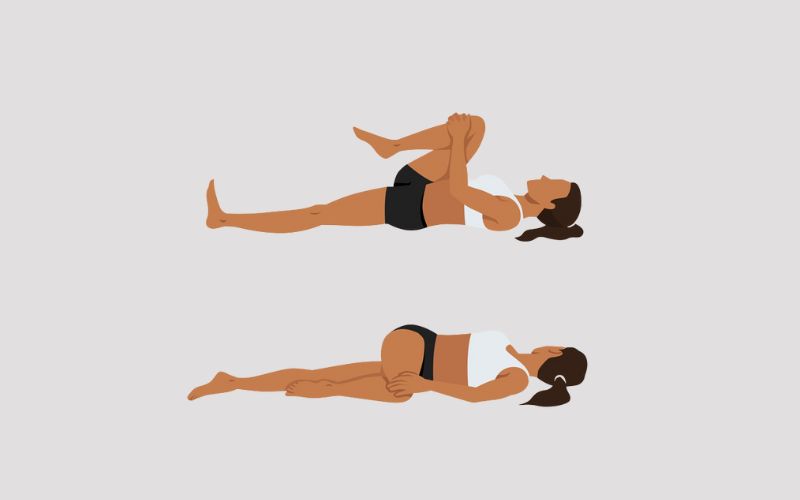
The trunk rotation with leg crossover checks a lot of boxes when it comes to the best stretches for swimmers.
Here’s how to do it:
- Lay down on your back and bring one knee so that it’s at a 90-degree angle
- Leading with the knee and using the opposite arm to help guide, pull your leg across the body
- Keep your shoulders on the floor to maximize the stretch
- Hold for 10-20 seconds and repeat on the other side
Core and lower back unlocked!
- Note: This stretch is also highly relaxing. It is great for post-swim stretching when you need to unwind after a nasty main set.
6. Kneeling Hip flexor stretch
The kneeling hip flexor stretch helps swimmers maintain (and improve) mobility at the front of the pelvis and hips.
For swimmers who struggle with lower back pain, stretching out the hip flexors can help alleviate the tightness (Ingber, 1989) and improve lumbar stability (Juker et al., 1998).
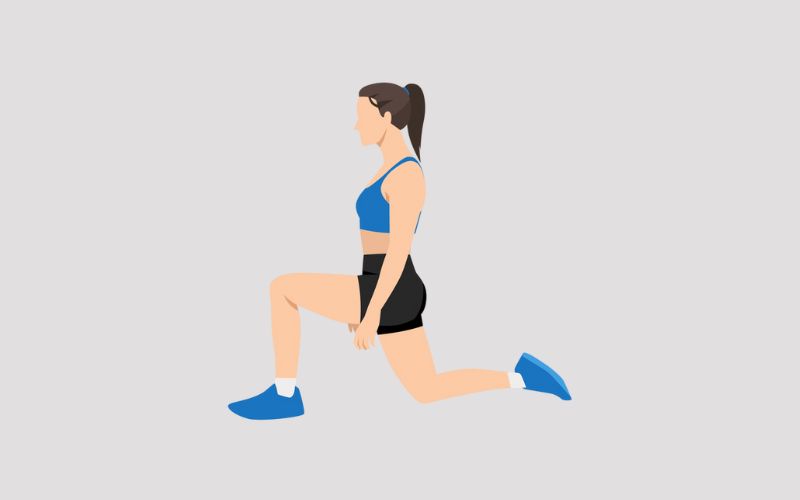
The kneeling hip flexor stretch is straightforward:
Grab a towel or stretching mat (especially if you are stretching on a tiled pool deck—protect those knees)
- Place the right knee on the mat and your left leg bent at the knee in front of you
- Lean forward with your hips until you feel a gentle tug at the top of your thighs
- Explore the end-of-range spot and hold for 20 to 30 seconds
- Switch sides and repeat several times over
Hip flexors are crucial for fast swimming as they help stabilize the core, improve balance, and even increase glute muscle activation (Marin et al., 2021).
7. Doorway pec stretch
Swimming has a lot of unique things about it, from the swim goggle marks to constantly smelling like chlorine.
One of the not-so-fun quirks of the sport is that we have a distinct overuse injury named after our sport.
You know what I’m talking about…
Swimmer’s shoulder.
A study (McMaster and Troup, 1993) of 1,262 American club swimmers—including national team members—found that 10% of age group swimmers were experiencing shoulder pain when surveyed.
This number grew to 26% when the national team members were surveyed.
While there are several causes of swimmer’s shoulder, from muscle imbalances to shoulder fatigue, one of the culprits is pectoralis minor tightness, which leads to dysfunctional movement of the shoulder blade (Ludewig & Cook, 2000).
The result?
Pain with overhead movements (ahem, swimming).
To keep the pectoral nice and supple, add the doorway pec stretch to your post-workout stretching routine (focus on the dynamic stretches—cross-body arm swings, for pre-swim range of motion).
Here’s how to do it:
Using either a doorway or a wall, raise your arm up laterally and bend at the elbow.
Park the forearm against the door frame or apply some pressure against the wall.
Gently step forward with your body until you feel the stretch in the pecs
Hold for 20-30 seconds, switch sides, and repeat several times
- Tip: Between static stretching sets, do 10-15 cross-body arm swings to increase blood flow to the target area. Combining dynamic and static stretching has been shown to be more effective for increasing range of motion than static stretching alone (Blackhurst et al., 2015).
8. Lat stretch
The latissimus dorsi, more commonly called the lats, play a huge role in swimming performance.
The big, fan-shaped muscles in the back that jut out, creating the V-shaped back swimmers are renowned for, power much of the pulling motion, creating stability in the shoulder joint, and helping lock in your streamline when blasting off the wall.
The lats do a lot of work for us in the water, meaning we should take care of those bad boys.
Excess stiffness in the lats limits scapular motion and stability and reduces the power we can exert in the pool. A decreased range of motion in the lats also increases the likelihood of injury in the water (Kibler & Sciascia, 2010).
Stretching the lats is easy and can be done in many ways.
Today, after a long swim at the pool, I hopped out, grabbed the railing on the 1m diving board, hinged at the hips, and leaned my hips backward, creating a gentle and highly satisfying stretch in the lats that I felt down my back.
Another way to perform this stretch is when you find yourself sitting down. Place your hands and arms into a streamline above you, and simply lean a few inches laterally.
The lats are known as the “swimmer muscle” due to their huge role in the water, particularly with the overhead swim strokes (freestyle, butterfly, and backstroke).
Take care of your lats with consistent stretching, and your lats will take care of you when diving into the pool for another monster swim practice.
Wrapping Things Up
Ultimately, adding a well-rounded stretching routine to your swimming schedule doesn’t sound appetizing… Like yet another thing to worry about.
Which I understand. Swimming is a demanding sport that requires a lot of your time and effort, and the last thing most of us is more stuff to spend time on.
But, maximizing your time and effort means being able to swim with a functional range of motion, decreasing excess stiffness that can cause injury, and priming your body for peak performance each time you strap on your swim goggles.
Try out these stretches before and after your swim workouts and randomly when you have a couple of moments to do arm and leg swings over the day, and watch your swimming reach new heights.
ABOUT OLIVIER POIRIER-LEROY
Olivier Poirier-Leroy is a former national-level swimmer, author, swim coach, and certified personal trainer. He’s the author of YourSwimBook, a ten-month logbook for competitive swimmers.
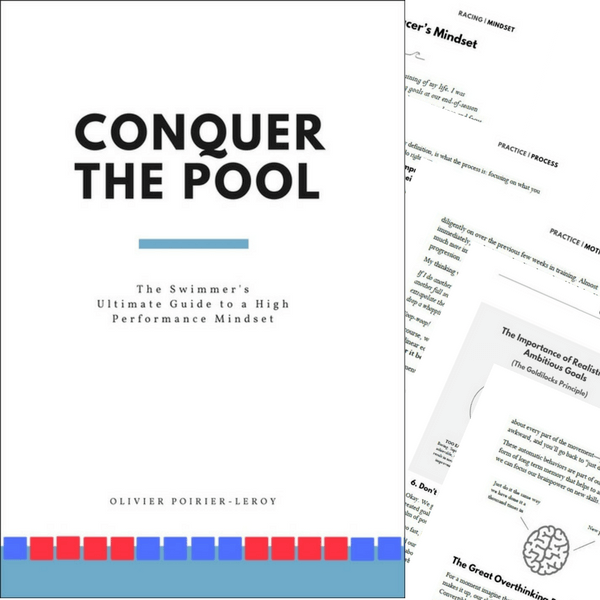 He’s also the author of the recently published mental training workbook for competitive swimmers, Conquer the Pool: The Swimmer’s Ultimate Guide to a High-Performance Mindset.
He’s also the author of the recently published mental training workbook for competitive swimmers, Conquer the Pool: The Swimmer’s Ultimate Guide to a High-Performance Mindset.
It combines sport psychology research, worksheets, anecdotes, and examples of Olympians past and present to give swimmers everything they need to conquer the mental side of the sport.
Ready to take your mindset to the next level in the pool?
Click here to learn more about Conquer the Pool.
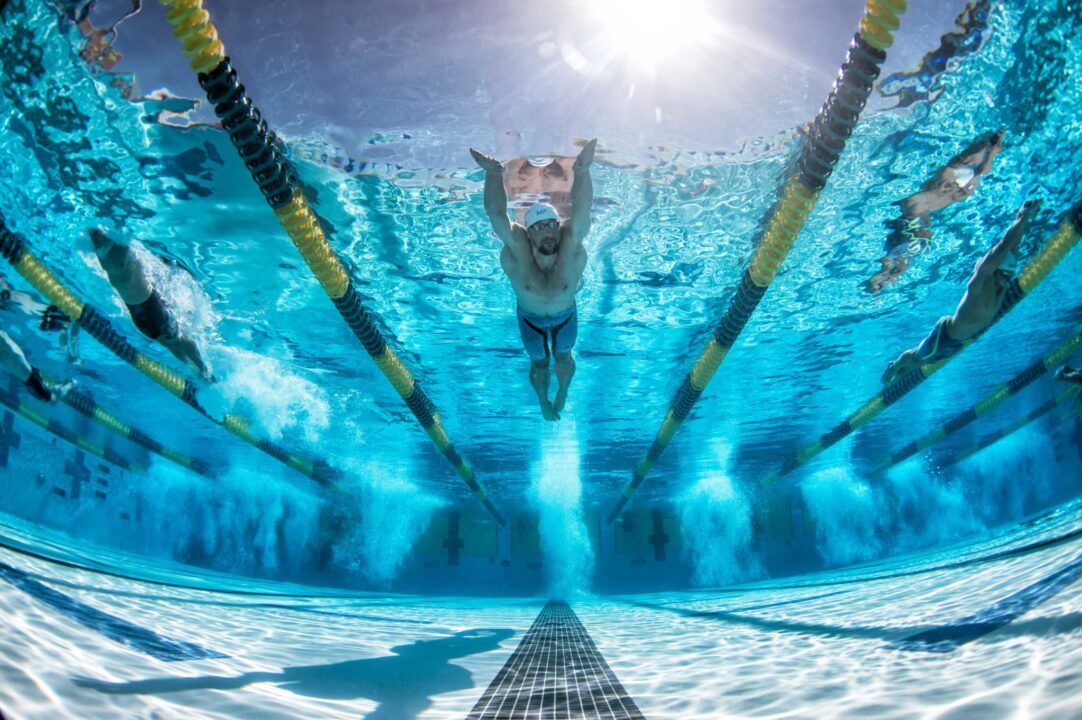
THIS STRETCH OUT WAS FIYAAAAA
Proper strength training > stretching
Proper strength training + stretching -> increased recovery + injury prevention + mobility & strength in the water
Excellent information 👍